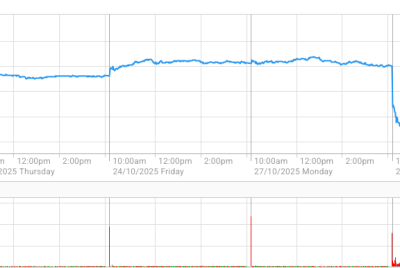Australia's Embedded Finance Market Poised to Reach $14.86 Billion by 2030 as Industry Evolves Beyond BNPL

Australia's embedded finance landscape is undergoing a dramatic transformation, evolving from its Buy Now, Pay Later origins into a sophisticated, multi-vertical ecosystem that's reshaping how Australians interact with financial services across retail, property, mobility and business sectors.
New research from ResearchAndMarkets.com reveals the Australian embedded finance market is expected to grow by 9.4% on an annual basis to reach US$11.51 billion in 2025, with projections showing continued expansion to approximately US$14.86 billion by 2030—representing a compound annual growth rate of 6.6% over the forecast period.
The market has already demonstrated impressive momentum, achieving a CAGR of 13.4% during the 2021-2025 period as it grew from niche fintech offerings to mainstream financial infrastructure embedded across diverse platforms and industries.
Beyond Afterpay: The Next Chapter of Embedded Finance
While Australia became globally recognized for pioneering BNPL through companies like Afterpay (now owned by Block) and Zip, the country's embedded finance sector has matured far beyond point-of-sale credit offerings.
Today's embedded finance ecosystem encompasses lending products for SME platforms, insurance embedded within online travel and mobility apps, fractional investment offerings on property and equity platforms, and real-time payment solutions integrated into subscription services and B2B procurement systems.
"Embedded finance in Australia is evolving beyond BNPL into a multi-vertical, API-driven ecosystem shaped by open banking, real-time payments, and regulatory recalibration," the research notes, highlighting the sector's transformation from consumer-focused credit to comprehensive financial infrastructure.
This evolution reflects changing consumer expectations for seamless financial experiences and increasing collaboration between fintechs and industry-specific platforms across traditionally non-financial sectors.
Retail, Mobility and Property Lead Sectoral Expansion
The expansion of embedded finance into new verticals represents one of the market's most significant growth drivers. Companies are no longer waiting for customers to visit separate financial services providers—they're integrating those services directly into existing user journeys.
In retail, platforms like Marketplacer have partnered with Zip to embed financing options within online marketplaces, allowing customers to access credit at the point of purchase without leaving the shopping experience.
The property sector has seen particularly innovative applications. PropHero and BrickX integrate investment and fractional property finance features directly into their digital interfaces, democratizing real estate investment through embedded financial products that would have required separate brokerage relationships in the past.
Mobility platforms are embedding insurance products, allowing users booking ride-shares, car rentals or travel to purchase coverage as part of the transaction flow rather than through separate insurance providers.
This sectoral digitization is expected to intensify as Australia's Consumer Data Right (CDR) framework matures and APIs become standardized, reducing integration costs and accelerating adoption among second-tier platforms and emerging verticals like automotive sales, real estate services, and B2B procurement.
The Strategic Shift: Fintechs Pivot to Enterprise Partnerships
A fundamental business model transformation is reshaping Australia's embedded finance landscape. Fintechs are increasingly embedding their services through white-label partnerships with large enterprises rather than pursuing direct-to-consumer strategies.
This shift stems from multiple factors, including regulatory pressure on consumer-facing fintechs—particularly ASIC scrutiny of BNPL operators—and recognition that B2B2C partnerships offer greater scale and resilience than direct consumer acquisition.
Corporates, meanwhile, are prioritizing embedded finance as a loyalty and engagement lever. Zip's partnership with Qantas Loyalty exemplifies this trend, integrating payment flexibility directly into one of Australia's most valuable customer loyalty ecosystems.
Payment infrastructure provider Zepto has embedded its APIs within retailers and subscription platforms, while similar partnerships are emerging across telecommunications (Optus), travel (Webjet), and utilities sectors.
"The fintech value proposition will become increasingly infrastructure-centric, reducing direct brand visibility but expanding reach and resilience," the research predicts, suggesting the most successful fintechs will become invisible financial plumbing powering consumer-facing platforms rather than consumer brands themselves.
Open Banking Unlocks Hyper-Personalization
Australia's Consumer Data Right regime is proving transformational for embedded finance capabilities. By enabling secure, consent-driven data sharing, CDR allows providers to tailor products to individual user profiles with unprecedented precision.
Over 110 data holders—including all major banks—are now accredited under CDR, creating a data ecosystem that enables embedded finance platforms to offer hyper-personalized experiences. Frollo, an early adopter of open banking APIs, has helped multiple enterprise clients embed financial dashboards and credit tools using consented customer data.
This personalization extends beyond simple credit decisioning into sophisticated applications:
- Dynamic credit limits that adjust based on real-time cash flow analysis
- Real-time budgeting tools embedded within banking and shopping apps
- Usage-based pricing models that adapt to individual consumption patterns
- Spend-based loyalty products that reward specific behaviors identified through data analysis
As CDR Phase 3 progresses—particularly action initiation capabilities—embedded finance products will gain even greater sophistication. Rather than simply reading data, platforms will be able to initiate payments and financial actions on behalf of users (with consent), creating seamless financial experiences that blur the line between financial services and everyday digital activities.
Real-Time Payments Infrastructure Creates New Use Cases
The continued rollout of Australia's New Payments Platform (NPP), especially the PayTo payment initiation service, is unlocking real-time payment use cases that were previously impossible or impractical.
PayTo enables businesses to initiate payments from customer accounts in real-time with pre-authorized consent—a capability that's transforming subscription billing, merchant settlements, and dynamic payment scenarios.
Infrastructure providers like Zepto and Monoova are embedding real-time payment options into retail and B2B platforms, offering alternatives to traditional card-based payment systems with lower costs and instant settlement.
The shift toward real-time payment rails creates opportunities for innovative embedded finance applications:
- Usage-based billing that charges customers precisely for what they consume, when they consume it
- Just-in-time payments that optimize cash flow by delaying payment until the last possible moment
- Cash flow-based credit disbursements that provide funding exactly when businesses need it, based on real-time financial position
- Embedded treasury management for SMEs that automates receivables and payables based on predefined rules
As real-time payment integrations become standard rather than exceptional, the entire embedded finance ecosystem will shift toward dynamic, event-driven financial experiences that respond instantaneously to business and consumer needs.
Competitive Landscape: Infrastructure Providers Emerge as Kingmakers
While consumer-facing BNPL brands like Afterpay and Zip dominated Australia's early embedded finance narrative, a new generation of B2B infrastructure providers is emerging as the sector's critical enablers.
Zepto has positioned itself as a real-time payments enabler using NPP and PayTo, with its solutions embedded in subscription platforms and marketplaces serving thousands of merchants.
FrankieOne provides onboarding and fraud prevention APIs that are embedded by fintechs and digital banks for compliance-heavy customer acquisition flows, addressing one of embedded finance's biggest friction points.
Monoova, backed by Moneytech, delivers payment automation APIs particularly suited for SME and payroll-linked use cases, automating complex B2B payment workflows.
Shaype (formerly Hay-as-a-Service) allows enterprises to embed accounts and card issuing features, creating full banking experiences within non-financial platforms.
These infrastructure providers aren't directly competing with consumer-facing fintechs—instead, they're enabling broader adoption of embedded finance among platforms, corporates, and regulated financial institutions by providing the technical and compliance foundations others build upon.
Regulatory Recalibration Shapes Market Evolution
Australia's regulatory environment is undergoing significant evolution as authorities grapple with embedded finance's implications for consumer protection, financial stability, and market competition.
ASIC's increased scrutiny of BNPL operators has prompted industry consolidation and business model adjustments. Zip divested parts of its international operations and restructured its local business, while Latitude Group exited some BNPL offerings amid regulatory tightening.
However, rather than stunting growth, regulatory evolution is pushing the sector toward more sustainable, compliance-first approaches. Strategic partnerships and regulatory licenses have become key differentiators, with early movers in regulated verticals like payroll, wealthtech, and utilities gaining faster traction.
"The next phase of competition will center on trusted infrastructure, data integration capabilities, and embedded compliance," the research notes, suggesting regulatory sophistication will separate winners from losers as the market matures.
The Next 2-4 Years: Consolidation, Convergence, Infrastructure
Looking ahead, several trends will likely reshape Australia's embedded finance landscape:
Consolidation among smaller players as scale advantages and compliance costs favor larger, well-capitalized providers with established partnerships.
Convergence with traditional banking as incumbent financial institutions leverage CDR and partnership strategies to compete with fintech disruptors on their own embedded finance turf.
Infrastructure expansion as payment rails, identity verification systems, and API ecosystems mature, reducing technical barriers and accelerating adoption across second-tier platforms and emerging verticals.
Formalization under new compliance norms as regulatory frameworks evolve to address embedded finance's unique characteristics, potentially creating licensing requirements that reshape competitive dynamics.
What It Means for Australian Consumers and Businesses
For Australian consumers, the embedded finance boom means increasingly invisible financial services that feel less like separate "finance" and more like natural extensions of shopping, travel, property investment, and daily digital activities.
The friction of switching between apps, re-entering payment details, or navigating separate financial service providers will continue declining as embedded solutions proliferate.
For businesses—particularly SMEs—embedded finance represents both opportunity and disruption. Access to capital, payment processing, and financial management tools will become easier as these services embed within existing business software and platforms.
However, businesses will also face new competitive pressures as their larger competitors and platform providers leverage embedded finance to create stickier customer relationships and differentiated experiences.
The Global Context
Australia's embedded finance evolution mirrors global trends but with distinctive characteristics shaped by the country's regulatory approach, early BNPL leadership, and sophisticated digital infrastructure.
The market's projected growth to $14.86 billion by 2030 represents meaningful expansion but also reflects Australia's relatively smaller population compared to markets like the United States, where embedded finance is projected to exceed $200 billion over similar timeframes.
What Australia may lack in absolute market size, it compensates through sophistication and regulatory clarity—qualities that position the country as a testbed for embedded finance innovations that could scale globally.
As the sector matures from BNPL novelty to essential financial infrastructure, Australia's experience will likely provide valuable lessons for other markets navigating similar transformations in how financial services are delivered, experienced, and regulated.
© Copyright 2025 IBTimes AU. All rights reserved.





















